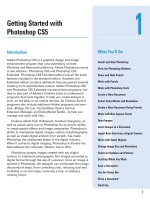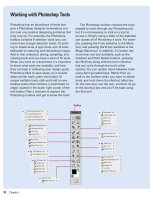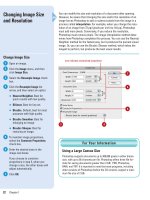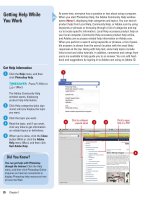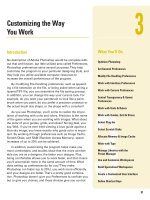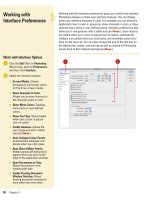Photoshop cs5 by steve Johnson part 9 pot
Bạn đang xem bản rút gọn của tài liệu. Xem và tải ngay bản đầy đủ của tài liệu tại đây (485.02 KB, 7 trang )
ptg
Customizing the Way
You Work
Introduction
No description of Adobe Photoshop would be complete with-
out that well-known, but little utilized area called Preferences.
Photoshop preferences serve several purposes. They help
customize the program to your particular designing style, and
they help you utilize available computer resources to
increase the overall performance of the program.
By modifying File Handling preferences, such as append-
ing a file extension on the file, or being asked when saving a
layered TIFF file, you can streamline the file saving process.
In addition, you can change the way your cursors look. For
example, do you want your paintbrush to look like a paint-
brush when you paint, do you prefer a precision crosshair or
the actual brush size shape, or the shape with a crosshair?
As you use Photoshop, you'll come to realize the impor-
tance of working with units and rulers. Precision is the name
of the game when you are working with images. What about
the color of your guides, grids, and slices? No big deal, you
say. Well, if you've ever tried viewing a blue guide against a
blue-sky image, you know exactly why guide color is impor-
tant. By working through preferences such as Image Cache,
Scratch Disks, and RAM (Random Access Memory), speed
increases of up to 20% can be achieved.
In addition, customizing the program helps make you
more comfortable, and studies show that the more comfort-
able you are as a designer, the better your designs. Plus,
being comfortable allows you to work faster, and that means
you'll accomplish more in the same amount of time. What
does setting up preferences do for you? They make
Photoshop run faster (up to 20%), you work more efficiently,
and your designs are better. That's a pretty good combina-
tion. Photoshop doesn't give you Preferences to confuse you,
but to give you choices, and those choices give you control.
3
3
What You’ll Do
Optimize Photoshop
Set General Preferences
Modify File Handling Preferences
Work with Interface Preferences
Work with Cursors Preferences
Control Transparency & Gamut
Preferences
Work with Units & Rulers
Work with Guides, Grid & Slices
Select Plug-Ins
Select Scratch Disks
Allocate Memory & Image Cache
Work with Type
Manage Libraries with the
Preset Manager
Use and Customize Workspaces
Build Specialized Workspaces
Create a Customized User Interface
Define Shortcut Keys
51
From the Library of Wow! eBook
ptg
52 Chapter 3
Optimizing Photoshop
Photoshop is a powerful program, and as
such, requires a tremendous amount of com-
puting power. When working on large docu-
ments, a poorly optimized Photoshop
program will mean longer processing times
for your files. That's the bad news if you have
a deadline to meet. The good news is that
Photoshop can be configured to run more effi-
ciently. To optimize Photoshop, click the Edit
(Win) or Photoshop (Mac) menu, point to
Preferences, and then click Performance. The
Performance preferences dialog box contains
options that will help maximize the perform-
ance of Photoshop.
History States
History States control the number of undos
available. In fact, you can have up to 1,000
undos (ever wonder who would make so
many mistakes that they would need 1,000
undos?). Unfortunately, increasing the number
of History States will ultimately increase the
amount of RAM Photoshop uses to manage
the History panel. Assigning more RAM to
manage History means less memory for
Photoshop to perform other operations, and
will reduce the performance of the pro-
gram. If you are experiencing problems
with slow performance, lowering the num-
ber of History States frees up more RAM,
and permits Photoshop to operate more
efficiently.
Scratch Disk
When your computer doesn't have enough
RAM to perform an operation, Photoshop
uses free space on any available drive,
known as a
Scratch Disk
. Photoshop
requires 5 times the working size of the file
in contiguous hard drive space. For exam-
ple, if the working size of your file is 100
MB, you will need 500 MB of contiguous
hard drive space, or you will receive an
error message: Out of Scratch Disk Space (I
hate it when that happens). Using additional
hard drives gives Photoshop the ability to
History States
From the Library of Wow! eBook
ptg
Chapter 3 Customizing the Way You Work 53
divide the processing load and increase per-
formance. Photoshop detects and displays all
available internal disks in the Preferences dia-
log box. Scratch disks must be physically
attached to your computer (avoid networks
and removable media, such as zip drives, or
rewritable CDs or DVDs). For maximum
speed, avoid USB, and use 4- or 6-pin
FireWire drives. Benchmark tests show
FireWire drives provide up to a 20% speed
improvement when used as Scratch Disks.
Think of saving one hour out of every five, or
one full day out of every five. That's not too
bad. For best results, select a scratch disk on a
different drive than the one used for virtual
memory or any large files you're editing.
Memory & Image Cache
Photoshop functions in RAM (actually all
applications work within RAM). To run effi-
ciently, Photoshop requires 5 times the work-
ing size of the open document in available
memory (some tests indicate 6 to 8 times).
Strictly speaking, the more RAM you can
assign to Photoshop, the more efficiently the
program operates, especially when opening
large documents. RAM usage is determined by
the working size of the document, not its open
size. As you add elements to a document, the
working size of the file increases.
Cache Levels are screen redraws, or how
many versions of the current active document
Photoshop saves. When you're working on
large documents, more Cache Levels help
speed up the redraw function, and make
image manipulation proceed faster. However,
they are held primarily in RAM, so the more
Cache Levels you choose, the less RAM is
available for other Photoshop functions. Cache
Tiles (
New!) are the amount of data Photoshop
stores or processes at once; use a larger tile
size for larger documents to speed up process-
ing. If you’re not sure what to set, use one of
the preset buttons (New!).
RAM memory
allocation
Available Scratch
Disks
From the Library of Wow! eBook
ptg
54 Chapter 3
Photoshop's General preferences help you configure some of the more
common features of the program. Color picker and image interpolation
settings, as well as the History log, are set up in General preferences.
Other options, such as beeping when an operation is finished, auto-
updating open documents, and using the Shift key for tool switching,
can all be turned on or off in the Options area. The Color Picker options
allow you to select a color picker, either Adobe or the OS, and a HUD
color picker (in 8-bit and 16-bit documents) (New!). The History Log
lets you save all the History States performed on a particular docu-
ment. For example, when you open an image, all the adjustments and
actions performed are saved in a text file. This gives you access to
valuable information, and lets you reproduce the steps performed on
one image to correct another.
Setting General
Preferences
Work with General Options
Click the Edit (Win) or Photoshop
(Mac) menu, and then point to
Preferences.
Click General.
Click the Color Picker list arrow,
and then select Adobe or another
operating system (Windows or
Macintosh).
Click the HUD Color Picker list
arrow, and then select a color
picker style, such as Hue Strip or
Hue Wheel (New!).
Click the Image Interpolation list
arrow, and then select Nearest
Neighbor (Faster), Bilinear, or one
of the Bicubic options.
Select the various options you
want to use:
◆ Auto-Update Open Documents.
Creates a link between the
open image and the image file
on disk.
◆ Beep When Done. Makes a
sound when an operation is
complete.
◆ Dynamic Color Sliders.
Previews color effects within
the slider bars.
6
5
4
3
2
1
3 4
2
5
From the Library of Wow! eBook
ptg
Chapter 3 Customizing the Way You Work 55
◆ Export Clipboard. Transfers a
copied image to the operating
systems clipboard.
◆ Use Shift Key For Tool Switch.
Allows you to use the keyboard
shortcut when two tools share
the same slot in the toolbox.
◆ Resize Image During Place.
Allows you to resize an image
during a Place.
◆ Animated Zoom. Enables
continuous-motion, smooth
zooming in and out of your
document. Must have OpenGL
on your computer.
◆ Zoom Resizes Windows.
Forces the image window to
resize when zoom is selected.
◆ Zoom With Scroll Wheel.
Determines whether zooming or
scrolling is the default
operation of the scroll wheel.
◆ Zoom Clicked Point to Center.
Centers the zoom view on the
clicked location.
◆ Enable Flick Panning. Enables
quick mouse movement over
the image instead of holding
down the mouse.
◆ Place or Drag Raster Images as
Smart Objects. Converts raster
images to Smart Objects when
you place or drag them
(New!).
Select the History Log check box
and then set the log options you
want to use.
Click OK.
8
7
8
7
6
From the Library of Wow! eBook
ptg
56 Chapter 3
Sooner or later, you'll have to save the file (document) you've created
in Photoshop. The final output of any document is contained within a
specific file format such as TIFF, EPS, JPEG, or BMP. In fact, Photoshop
lets you save files using over 15 different formats. The File Handling
preferences provide several options that modify what information is
saved with a file. Image previews are typically very small, adding very
little to the file size of the saved document. Once saved you may want
to open, print, and possibly even modify the document using other
image-editing applications. The File compatibility options help you save
a file that will be transportable to other applications.
Modifying File
Handling
Preferences
Work with File Handling Options
Click the Edit (Win) or Photoshop
(Mac) menu, and then point to
Preferences.
Click File Handling.
Select the File Saving Options you
want to use:
◆ Image Previews. Select from:
Always Save, Never Save, or
Ask When Saving.
◆ Icon. Saves previews of the
images (Mac).
◆ Windows Thumbnail. Saves
previews viewable when using
the Win File Open command
(Mac).
◆ Append File Extension. Lets
you choose whether or not to
append the file extension
(Mac).
◆ Use Lower Case (Mac) or File
Extension (Win). Choose to
have upper or lower case
extensions.
◆ Save As To Original Folder.
Saves the file to original folder
as the default (New!).
3
2
1
3
2
From the Library of Wow! eBook
ptg
Chapter 3 Customizing the Way You Work 57
Select the File Compatibility options
you want to use:
◆ Camera Raw Preferences Click
to choose from options such as
default image settings, cache
size, DNG file handling, and
whether or not to open JPEG
and TIFF files with Camera Raw.
◆ Prefer Adobe Camera Raw for
Supported Raw Files. Open
supported raw files in Camera
Raw.
◆ Ignore EXIF Profile Tag. Ignores
color space metadata attached
to digital camera images.
◆ Ask Before Saving Layered TIFF
Files. Lets you create multi-
layered documents, and then
save them using the TIFF format.
This is a distinct advantage
when you need to use multi-
layered files and you don't want
to save them using Photoshop's
proprietary format (PSD).
◆ Maximize PSD and PSB File
Compatibility. Lets you save
PSD files that can be opened in
earlier versions of the program
and PSB (Large Document
Format) files.
Select the Enable Adobe Drive
check box to enable Adobe Drive in
your work process (New!).
Enter the number of files (up to 30)
to keep in the Recent File List box.
Click OK.
7
6
5
4
6
5
7
4
See Also
See “Understanding File Formats” on
page 391 for information on some of the
various file formats available in
Photoshop.
From the Library of Wow! eBook
